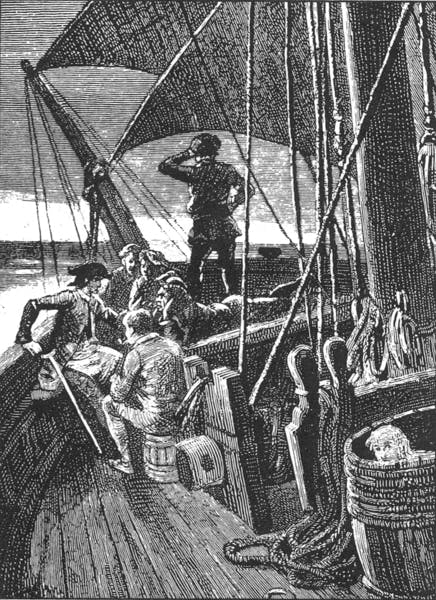Jump aboard the new Treasure Island's edition
Stevenson conceived the idea of Treasure Island (originally titled, "The Sea Cook: A Story for Boys") from a map of an imaginary, romantic island idly drawn by Stevenson and his stepson Lloyd Osbourne on a rainy day in Braemar, Scotland. Stevenson had just returned from his first stay in America, with memories of poverty, illness, and adventure (including his recent marriage), and a warm reconciliation between his parents had been established. Stevenson himself said in designing the idea of the story that,
Completing 15 chapters in as many days, Stevenson was interrupted by illness and, after leaving Scotland, continued working on the first draft outside London. While there, his father provided additional impetus, as the two discussed points of the tale, and Stevenson's father was the one who suggested the scene of Jim in the apple barrel and the name of Walrus for Captain Flint's ship

Illustration von George Roux (1850 - 1929) für die 1885er-Ausgabe von "Die Schatzinsel"
Two general types of sea novels were popular during the 19th century: the navy yarn, which places a capable officer in adventurous situations amid realistic settings and historical events; and the desert island romance, which features shipwrecked or marooned characters confronted by treasure-seeking pirates or angry natives. Around 1815, the latter genre became one of the most popular fictional styles in Great Britain, perhaps because of the philosophical interest in Rousseau and Chateaubriand's "noble savage." It is obvious that Treasure Island was a climax of this development. The growth of the desert island genre can be traced back to 1719 when Daniel Defoe's legendary Robinson Crusoe was published. A century later, novels such as S. H. Burney's The Shipwreck (1816), and Sir Walter Scott's The Pirate (1822) continued to expand upon the strong influence of Defoe's classic. Other authors, however, in the mid 19th-century, continued this work, including James Fenimore Cooper's The Pilot (1823). During the same period, Edgar Allan Poe wrote, "MS Found in a Bottle" (1833) and the intriguing tale of buried treasure, "The Gold-Bug" (1843). All of these works influenced Stevenson's end product.
Specifically, however, Stevenson consciously borrowed material from previous authors. In a July 1884 letter to Sidney Colvin, he writes "Treasure Island came out of Kingsley's At Last, where I got the Dead Man's Chest—and that was the seed—and out of the great Captain Johnson's History of the Notorious Pirates." Stevenson also admits that he took the idea of Captain Flint's skeleton point from Poe's "The Gold-Bug," and he constructed Billy Bones' history from the pages of Washington Irving, one of his favorite writers.[2]
One month after he conceived of "The Sea Cook," chapters began to appear in the pages of Young Folks magazine. Eventually, the entire novel ran in 17 weekly installments from 1 October 1881, through 28 January 1882. Later the book was republished as the novel Treasure Island and the book proved to be Stevenson's first financial and critical success. William Gladstone (1809-1898), the zealous Liberal politician who served four terms as British prime minister between 1868 and 1894, was one of the book's biggest fans.
Source: Wikipedia